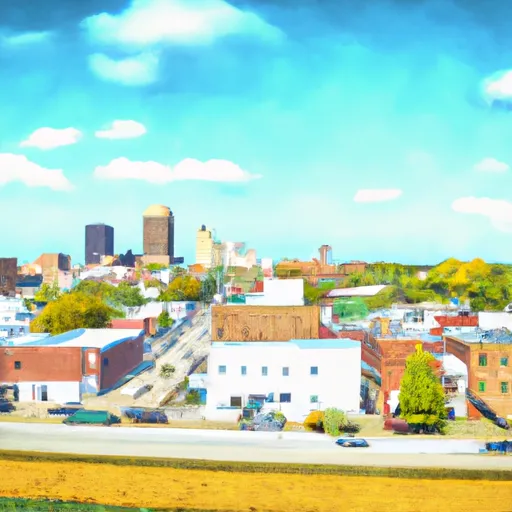-
 Snoflo Premium
Snoflo Premium
Get unlimited access to all our content
With no Ad interruptions! - Start Your Free Trial Login with existing account
Mitchell
Eden Index
Climate
8.1
•
Recreation
5.4
•
Community
2.1
•
Safeguard
5.6/10

Mitchell, Indiana is a charming town located in the southern part of the state. The region experiences a humid continental climate with hot summers and cold winters. Summers are typically warm and humid, with temperatures averaging around 80 degrees Fahrenheit. Winters are cold, with temperatures dropping below freezing and occasional snowfall.
The hydrology constituents of Mitchell are diverse, with the East Fork of the White River flowing through the town. This river provides opportunities for fishing, canoeing, and kayaking. Additionally, there are several small lakes and ponds in the area that are popular for boating and fishing activities.
Outdoor enthusiasts will find plenty of recreational opportunities in Mitchell. Spring Mill State Park, located just outside the town, offers hiking trails, camping areas, and opportunities for birdwatching. The park also features a historic pioneer village and a restored water-powered grist mill, adding to its charm. Other outdoor activities in the area include golfing at the local golf courses, picnicking in the town parks, and exploring the scenic countryside.
Overall, Mitchell, Indiana offers a pleasant climate, diverse hydrology constituents, and a range of outdoor recreation opportunities that cater to residents and visitors alike.
What is the Eden Index?
The Snoflo Eden Index serves as a comprehensive rating system for regions, evaluating their desirability through a holistic assessment of climate health, outdoor recreation opportunities, and natural disaster risk, acknowledging the profound impact of these factors on livability and well-being.
Climate Health Indicator (CHI): 8.1
Mitchell receives approximately
1204mm of rain per year,
with humidity levels near 83%
and air temperatures averaging around
13°C.
Mitchell has a plant hardyness factor of
6, meaning
plants and agriculture in this region thrive during a short period during spring and early summer. Most
plants will die off during the colder winter months.
By considering the ideal temperature range, reliable water supplies, clean air, and stable seasonal rain or snowpacks, the Climate Health Indicator (CHI) underscores the significance of a healthy climate as the foundation for quality living.
A healthy climate is paramount for ensuring a high quality of life and livability in a region, fostering both physical well-being and environmental harmony. This can be characterized by ideal temperatures, reliable access to water supplies, clean air, and consistent seasonal rain or snowpacks.
Weather Forecast
Streamflow Conditions
Patoka-White
Area Rivers
Patoka-White
Snowpack Depths
Patoka-White
Reservoir Storage Capacity
Patoka-White
Groundwater Levels
Recreational Opportunity Index (ROI): 5.4
The Recreational Opportunity Index (ROI) recognizes the value of outdoor recreational options, such as parks, hiking trails, camping sites, and fishing spots, while acknowledging that climate plays a pivotal role in ensuring the comfort and consistency of these experiences.
Access to outdoor recreational opportunities, encompassing activities such as parks, hiking, camping, and fishing, is crucial for overall well-being, and the climate plays a pivotal role in enabling and enhancing these experiences, ensuring that individuals can engage in nature-based activities comfortably and consistently.
Camping Areas
| Campground | Campsites | Reservations | Toilets | Showers | Elevation |
|---|---|---|---|---|---|
| Bledsoe Creek State Park | 57 | 609 ft | |||
| Hardin Ridge | 200 | 780 ft | |||
| Cedar Creek - Old Hickory Lake | 60 | 459 ft | |||
| Paynetown State Rec Area - Monroe Lake | 320 | 557 ft | |||
| Cages Bend - Old Hickory Lake | 43 | 477 ft | |||
| Anderson Road - J. Percy Priest Reservoir | 10 | 535 ft | |||
| Poole Knobs - J. Percy Priest Reservoir | 88 | 537 ft | |||
| Seven Points - J. Percy Priest Reservoir | 60 | 521 ft | |||
| Cedars of Lebanon State Park | 117 | 686 ft | |||
| Henry Horton State Park | 56 | 672 ft |
Nearby Ski Areas
Catastrophe Safeguard Index (CSI):
The Catastrophe Safeguard Index (CSI) recognizes that natural disaster risk, encompassing floods, fires, hurricanes, and tornadoes, can drastically affect safety and the overall appeal of an area.
The level of natural disaster risk in a region significantly affects safety and the overall livability, with climate change amplifying these risks by potentially increasing the frequency and intensity of events like floods, fires, hurricanes, and tornadoes, thereby posing substantial challenges to community resilience and well-being.
Community Resilience Indicator (CRI): 2.1
The Community Resilience Indicator (CRI) recognizes that education, healthcare, and socioeconomics are crucial to the well-being of a region. The CRI acknowledges the profound impact of these elements on residents' overall quality of life. By evaluating educational resources, healthcare accessibility, and economic inclusivity, the index captures the essential aspects that contribute to a thriving community, fostering resident satisfaction, equity, and social cohesion.

